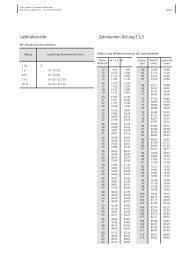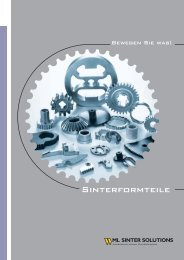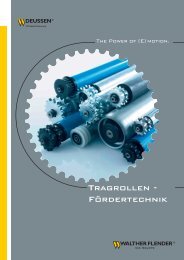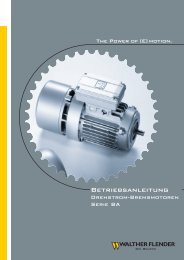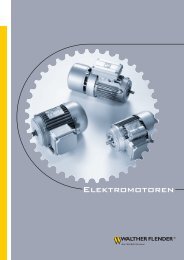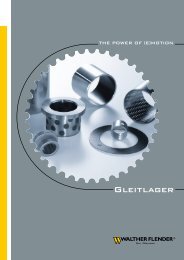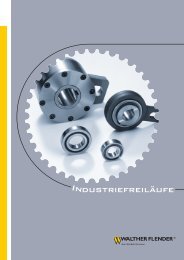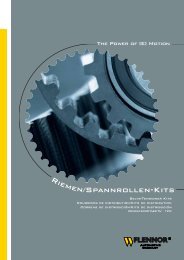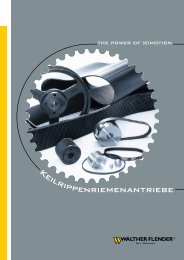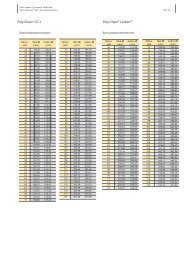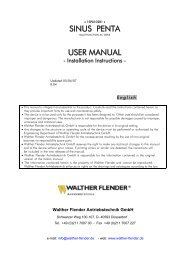PolyChain® GT Timing Belts - Walther Flender
PolyChain® GT Timing Belts - Walther Flender
PolyChain® GT Timing Belts - Walther Flender
You also want an ePaper? Increase the reach of your titles
YUMPU automatically turns print PDFs into web optimized ePapers that Google loves.
<strong>Walther</strong> <strong>Flender</strong> Gruppe<br />
Clamping sets Page 43<br />
Causes of malfunctions<br />
Fault Cause Solution<br />
Excessive noise levels Misalignment of pulleys<br />
Excessive belt tension<br />
Overload of drive system<br />
Worn timing belt pulley<br />
Incorrect pulley profile<br />
Rim flange stop face too large<br />
Air displacement in hollows<br />
Visible belt elongation Reduction of centre distance of axes due to loosening of<br />
the shaft bearings or timing belt pulley mounting<br />
Pulley wear (outer diameter)<br />
Overload of drive system<br />
Heat-up and subsequent cooling of drive system<br />
Excessive change in the timing belt material<br />
(melting, softening)<br />
Belt runs off to side Belt runs off the side of the timing belt pulley<br />
Excessive wear on side of belt<br />
Loosening of rim flanges Misalignment of pulleys, resulting in excessive axial forces Align pulleys<br />
Excessive wear on side<br />
of belt<br />
Incorrect axis parallelism or change in the centre<br />
distance of axes due to insufficient strength of<br />
bearings and axles<br />
Rim flanges defective or not bevelled<br />
Damage due to incorrect handling<br />
<strong>Timing</strong> belt too wide<br />
Premature tooth wear Initial tension too high or too low<br />
Belt runs off over rim flange<br />
Incorrect belt profile for timing belt pulley<br />
Worn timing belt pulley<br />
<strong>Timing</strong> belt pulley surface too rough<br />
Overload<br />
Excessive damage due to foreign objects<br />
Shearing of belt teeth Not enough teeth meshing<br />
Overload of drive system<br />
Worn timing belt pulley<br />
Incorrect belt profile for timing belt pulley<br />
Insufficient belt tension<br />
Extreme shock loads<br />
Broken belt <strong>Timing</strong> belt pulley diameter too small<br />
Overload of drive system<br />
Foreign objects<br />
Incorrect handling of timing belt during installation,<br />
belt damaged from kinking or bending<br />
Abnormal wear of<br />
timing belt pulley (outer<br />
diameter or tooth flanks)<br />
Increased belt tension or overload<br />
of drive system<br />
<strong>Timing</strong> belt pulley diameter too small<br />
Incorrect profile<br />
Foreign objects<br />
Cracks in tooth back Temperature too low<br />
Temperature too high<br />
Aggressive chemicals<br />
Increased temperature Initial tension too high or too low<br />
Incorrect timing belt profile or timing belt pulley profile<br />
Outer diameter too large<br />
Vibrations Initial tension too high or too low<br />
Loose timing belt pulley<br />
Vibrations in the slack side<br />
Align pulleys<br />
Reduce initial tension<br />
Increase belt width<br />
Replace timing belt pulley<br />
Correct profile<br />
Use of standard rim flanges with bending radius<br />
Custom profile<br />
Reset centre distance of axes and reinforce mounting<br />
Replace timing belt pulley<br />
Redesign drive system<br />
Check thermal expansion coefficient and use other<br />
materials, if necessary<br />
Reduce temperatures to permissible range<br />
Align drive system correctly<br />
Align drive system correctly<br />
Check axis parallelism and/or increase strength<br />
of axles and bearings<br />
Align or replace rim flanges<br />
Follow procedure in assembly instructions<br />
Use timing belt pulleys with correct width<br />
Correct initial tension<br />
Align timing belt pulley/correct initial tension<br />
Use <strong>PolyChain®</strong> timing belt pulleys<br />
Replace timing belt pulley<br />
Replace timing belt pulley<br />
System must be redesigned<br />
<strong>Timing</strong> belt cover<br />
Increase number of pulley teeth or use<br />
smaller pitch<br />
Increase belt width<br />
Replace timing belt pulley<br />
Use correct tooth profile<br />
Set correct belt tension<br />
System must be redesigned<br />
Increase pulley diameter or belt power output<br />
Use wider timing belt<br />
Protective drive cover<br />
Comply with installation instructions<br />
Reduce initial tension or increase belt width;<br />
redesign system, if necessary<br />
Use correct timing belt pulleys<br />
Use correct drive system<br />
Protective drive cover<br />
Avoid low temperatures<br />
Avoid high temperatures<br />
Protective drive cover<br />
Set correct initial belt tension<br />
Use correct drive system<br />
Correct outer diameter<br />
Set correct initial belt tension<br />
Re-attach timing belt pulleys and mount according to<br />
specifications<br />
Install a tangential tension pulley



